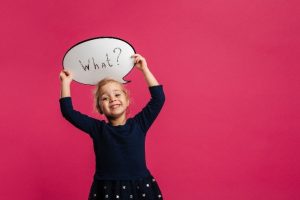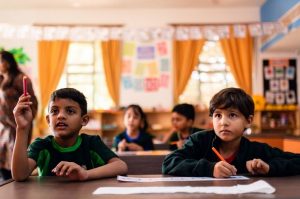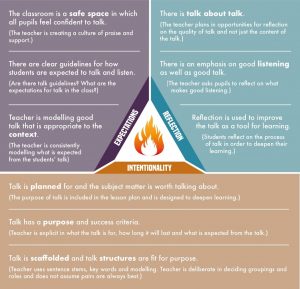
October 21, 2024, by Rupert Knight
We need to talk: four implications for primary schools of the Oracy Education Commission’s report.
This month has seen the publication of We Need to Talk, the final report from the Oracy Education Commission. In this blog, I reflect on some immediate takeaway messages for primary schools.
The work of the Oracy Education Commission has examined a mass of evidence over a busy six-month period. I’ve been fortunate to have had some involvement on the fringes of the process and it’s been heartening to witness the breadth of perspectives and conversations involved. While the final report makes a strong case for oracy as ‘the fourth R’, there is, of course, a need to interpret at a primary phase level the many implications for action. At a time of intense pressure on primary curricula and resources, what might schools prioritise?
As a possible starting point, I focus here on four of the report’s messages and in each case offer a question for consideration.
1. Learning about talk (not just to and through)
A fundamental issue from the start for the commission was a lack of agreement about what oracy actually means. It’s a term new to some, but with a lot of baggage for others (as Alex Quigley puts it, what is oracy anyway?)
Debates continue over whether oracy education should be seen as a matter of curriculum or pedagogy or what might distinguish it from merely spoken language. The Commission settles on a broad definition. Oracy is characterised as:
‘Articulating ideas, developing understanding and engaging with others through speaking, listening and communication’
Oracy education, in turn, is therefore seen as cultivating oracy through learning to, through and about talk. Learning to and through talk have long been the twin components of Voice 21’s ubiquitous oracy definition, but the Commission’s model gives a nod to a resurgence of interest in learning about talk.
Learning about talk implies children developing an awareness of language use for different purposes and in different contexts. Working ‘messily’ and provisionally through a problem with a familiar partner, explaining thought-through ideas to the wider class and making a case to an external audience all call for different linguistic approaches. An interest in learning about talk suggests a role for teachers in making judgments about varying things like register and vocabulary more explicit as teaching points.
This need for judgment and variety also brings us to the vexed question of the place of Standard (or standardised) English. The deficit-based starting point of correcting language which some associate with the original 1960s conception of oracy has been highlighted by Ian Cushing, for example. The Commission takes a firm stance, however, emphasising that oracy is not about ‘teaching children to mimic an idealised form of spoken language’. Broadening the repertoire for a range of contexts, rather than policing language is at the heart of this. The report’s call for empowering students ‘to develop their own authentic voices’ is taken up in a previous blog in this series.
Question 1: What opportunities do you create for children to discuss and evaluate explicitly the use of different language for different contexts?

2. Four modes of talk
Learning about talk in different contexts links closely to another of the Commission’s offerings: a recommendation that pupils experience four different modes of talk:
-
Building understanding
-
Debating and persuading
-
Negotiating and making change
-
Expressing and performing
This focus on modes takes us beyond the familiar dichotomy of ‘presentational’ and ‘exploratory’ talk. It simultaneously avoids beginning with a list of skills to be covered in an arbitrary way (indeed, oracy as ‘a checklist of decontextualised skills’ is firmly rejected by the Commission).
In thinking about modes, we begin to engage with the purposes of talk as a starting point. As suggested in this Oracy Cambridge blog, beginning with the identification of contexts and purposes and working down to the requisite skills to teach is likely to make for much more meaningful talk opportunities than a bottom-up, potentially arbitrary, skills-led approach.
So, perhaps we can incorporate this idea of modes into a sequence of planning decisions such as:
-
Authentic contexts and purposes (How might we use talk to get something meaningful done?)
-
Audiences (Who do we need to talk to and why?)
-
Modes (What kind of talk will we be using?)
-
Skills (What skills, for example from the Oracy Framework, will need to be explicitly taught?)
-
Enactment (How and when will this talk happen in a sequence of learning?)
Question 2: What are the authentic contexts and purposes for talk across the curriculum that may yield opportunities to experience different modes of talk?

3. Oracy opportunities in every subject
So where will we find these meaningful contexts?
The Commission makes a strong case for embedding oracy across the curriculum. In a primary context, transferring generic oracy strategies across a range of subjects is likely to come fairly naturally. Nevertheless, an important question here is the role of ‘disciplinary oracy’, as outlined in this blog from Amanda Moorghen.
To what extent do different subjects lend themselves to distinctive ways of talking? On my own visits to schools, I have encountered examples such as:
-
Mathematics: Sharing and capturing reasoning, supported by mini-whiteboards and digital recording
-
Geography: Debating different perspectives on complex environmental issues
-
Science: Developing tentative hypotheses and explanations
-
English: Offering contrasting interpretations of fictional characters
-
History: Asking questions and offering interpretations based on pictorial sources
So, while some of the foundational skills may be generic and transferrable, the idea of disciplinary oracy challenges primary teachers to think carefully about the contributions of oracy to particular aspects of learning and to make informed and deliberate choices about when and how talk is used.
Question 3: What distinctive uses of talk can you identify in each area of the curriculum?

4. An intellectual community
The report is also clear about the importance of teacher development. Although oracy is now named in the forthcoming update of the ITTECF for beginning teachers – a welcome recognition – this framework is by nature a somewhat blunt instrument of universal ‘Learn that’ and ‘Learn how to’ statements.
It is telling that the Commission refers to teachers needing:
‘The capacity to exercise their professional autonomy individually or as part of an intellectual community of practitioners’
This vision implies moving beyond one-off training events towards a culture of oracy and an ongoing conversation across school. As an example of an ‘intellectual community’, a local oracy interest group, based on collaboration between university and school colleagues from different settings is outlined in a previous blog in this series. This collaborative work involves powerful features such as:
-
Regular meetings
-
Visits to different schools and age groups
-
Analysis of practice
-
Collaborative planning
‘Professional autonomy’, meanwhile, may also be promoted by a focus on common principles rather than prescribed practices.
At School 21 in London, for example, a fire triangle analogy is used to illustrate three core components of planning for oracy and nine ‘building blocks’. Common expectations and understandings are established but judgment about context-specific strategies are left to individual teachers.

Question 4: How can you create an intellectual community and ongoing oracy conversation?
‘It’s time to make it happen’
So, at what might be a moment of opportunity for oracy education (as the report says, ‘It’s time to make it happen’), this blog offers four questions to begin considering.
Finally, however, one last takeaway message from the work of the Oracy Education Commission: something important is at stake. This is not just about promoting children’s personal wellbeing and prospects, or raising attainment. It is also about civic empowerment, social cohesion and perhaps even social transformation. Let’s start talking!
No comments yet, fill out a comment to be the first

Leave a Reply